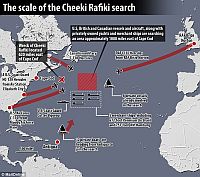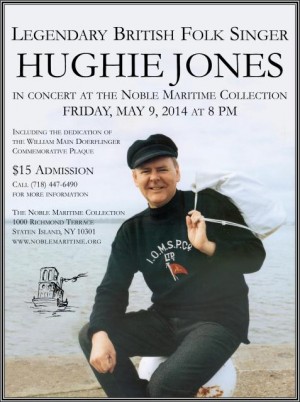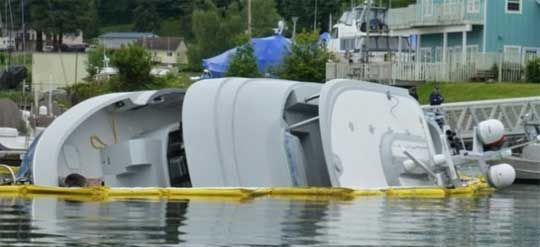 How is your day going? It has to be better than the unfortunate folks at Northern Marine in Anacortes, Washington, who had a 90′ expedition motor yacht roll over and sink when it was launched last Sunday. Rescuers and first responders had to smash a window open and pull five men trapped inside a $10 million capsized yacht. Fortunately, no one was hurt and no oil was leaked. The yacht has since been righted and the Coast Guard is investigating the cause of the casualty. Two videos of the capsize and rescue after the page break. Thanks to Robert Kennedy for contributing this post.
How is your day going? It has to be better than the unfortunate folks at Northern Marine in Anacortes, Washington, who had a 90′ expedition motor yacht roll over and sink when it was launched last Sunday. Rescuers and first responders had to smash a window open and pull five men trapped inside a $10 million capsized yacht. Fortunately, no one was hurt and no oil was leaked. The yacht has since been righted and the Coast Guard is investigating the cause of the casualty. Two videos of the capsize and rescue after the page break. Thanks to Robert Kennedy for contributing this post.
If the sea were influenced by public support and social media, the four missing sailors on the lost Beneteau 40.7, Cheeki Rafiki, would be home with their families by now. Unfortunately, that is not the case.
One week ago today, the captain of the yacht, Cheeki Rafiki, reported that they boat was taking on water in the Atlantic roughly 600 miles off Cape Cod. Contact with the yacht was lost of Friday. On Saturday, the container ship, Maersk Kure, spotted a capsized vessel, generally of the same size as the sailing boat. The boat’s keel had broken off and there was no sign of anyone aboard, so the ship continued without stopping. On Sunday, the Coast Guard called off the search.
Sailors in the upcoming Olympics in Rio de Janeiro will face more than just tough competition. They will be sailing in Guanabara Bay, a body of water thoroughly befouled with garbage and sewage. Falling overboard is not recommended. As reported by the New York Times: “It can get really disgusting, with dog carcasses in some places and the water turning brown from sewage contamination,” said Thomas Low-Beer, 24, a Brazilian Olympic hopeful who sails in the bay. He shuddered when recalling how his dinghy crashed into what he believed was a partly submerged sofa, capsizing him into the murky Guanabara.
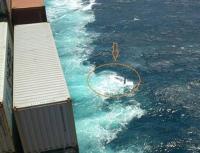
Photo of capsized boat taken from Maersk Kure
UPDATE: The US Coast Guard has resumed the search for the missing crew from the Cheeki Rafiki. Over 200,000 signed petitions asking that the search be resumed. British Prime Minister David Cameron thanked the Coast Guard on Twitter after it made the announcement.
The Cheeki Rafiki, a Beneteau 40.7 sailing yacht, is feared lost and the four British sailors aboard are missing. The yacht was described as well equipped and the sailors; Andrew Bridge, 21, James Male, 23, Paul Goslin, 56 and Steve Warren, 52; were all very experienced. They were delivering the boat to Europe following Antigua Sailing Week.
Last Thursday an EPIRB (Emergency Position Indicating Beacon) was activated and the captain reported that the yacht was taking on water. The yacht was reported to be roughly 620 miles (998km) east of Cape Cod in Massachusetts. Contact with the yacht was lost in the early hours of Friday while they were diverting to the Azores. On Saturday, the container ship Maersk Kure, spotted a capsized vessel that matched the boat’s description about 1,000 miles east of Cape Cod, Massachusetts, but did not stop to inspect it because no one was seen on board. US and Canadian aircraft as well as three merchant vessels looked for the yacht on Friday and Saturday but called off the search Sunday at 5am local time.
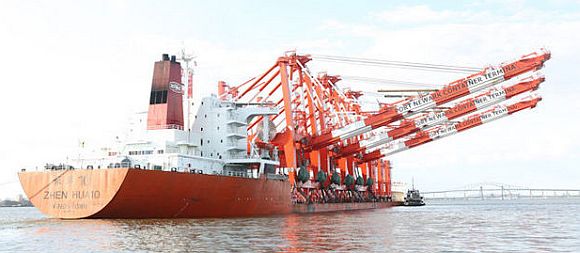
Photo: Michael Dempsey/The Jersey Journal
The expansion of the Panama Canal, which will allow the transit of much larger ships through new locks, is like a large stone dropped in the center of a quiet lake. The ripples are being felt on every shore. This Saturday, the semi-submersible heavy-lift ship Zhen Hua 10 steamed under the Varrazano-Narrows and Bayonne bridges in New York harbor, with three new container cranes on deck to accommodate the larger container ships which will be soon able to transit the expanded canal. The new cranes cost $40 million and are part of the investment being made in response the expansion of the Canal. Drivers bound to or from Staten Island this weekend were reminded of the largest component of the project. The Bayonne Bridge, which is being raised to allow larger ships to pass under at a cost $1.3 billion, was closed again for construction this weekend.
The canal expansion is having an impact on ports around the US and the world. Ports upgrading their facilities iinclude Miami; Baltimore; Savannah; Los Angeles; Jacksonville, Fla.; Lake Charles, La; Freeport, Bahamas and Charleston, S.C. The Panama Canal expansion is currently scheduled to be completed around the end of 2015.
The whaleship Charles W. Morgan left the dock at Mystic, CT for the first time since her arrival in 1941. On Saturday, she was towed down the Mystic River into Long Island Sound and up the Thames River to City Pier in New London, where she will load ballast. Over an 80-year whaling career, the Morgan embarked on 37 voyages between 1841 and 1921, most lasting three years or more. Over the last six years, the ship was undergone a $12 million restoration and will soon depart on her 38th voyage to historic ports of New England this summer. The Morgan will be open to the public at the New London City Pier from May 24-25, 31, and June 1.
Charles W. Morgan begins 38th voyage
The Charles W. Morgan, launched in 1841, is the last of an American whaling fleet that numbered more than 2,700 vessels. The Morgan is now America’s oldest commercial ship still afloat and the last of her kind. Thanks to Irwin Bryan for contributing to this post.
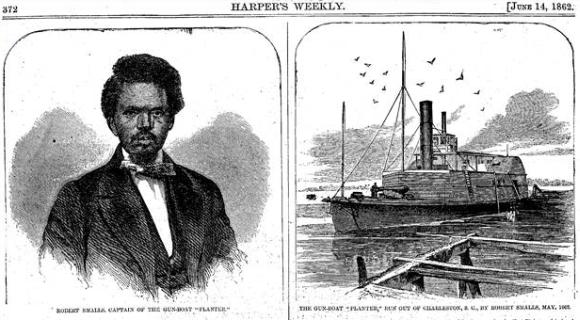 Two years ago, we posted about the the 150th anniversary of the seizure of the Confederate armed transport, CSS Planter, by Robert Smalls, a 23 year old mulatto slave, and eight fellow slaves. Smalls, who had served as the pilot of the transport, steamed it out past the batteries and forts of Charleston harbor and turned it over to the Union naval blockade. Smalls would go on to become the first black Captain of a U.S. Navy vessel, a South Carolina State Legislator, a Major General in the South Carolina Militia, a five-term U.S. Congressman and a U.S. Collector of Customs. This week archaeologists announced that they believe to have found the buried wreck of the Planter, off Cape Romainon the South Carolina coast, where the vessel later sank in 1876.
Two years ago, we posted about the the 150th anniversary of the seizure of the Confederate armed transport, CSS Planter, by Robert Smalls, a 23 year old mulatto slave, and eight fellow slaves. Smalls, who had served as the pilot of the transport, steamed it out past the batteries and forts of Charleston harbor and turned it over to the Union naval blockade. Smalls would go on to become the first black Captain of a U.S. Navy vessel, a South Carolina State Legislator, a Major General in the South Carolina Militia, a five-term U.S. Congressman and a U.S. Collector of Customs. This week archaeologists announced that they believe to have found the buried wreck of the Planter, off Cape Romainon the South Carolina coast, where the vessel later sank in 1876.
Ship taken by slaves 152 years ago found off South Carolina coast
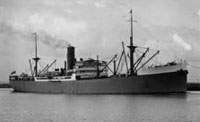 In early 2012, we posted about claims made by Greg Brooks of Sub Sea Research that they had found “the worlds richest shipwreck,” the British freighter, SS Port Nicholson, carrying a secret cargo of 71 tons of platinum, sunk by the German submarine U-87 on June 16th, 1942, northeast of Cape
In early 2012, we posted about claims made by Greg Brooks of Sub Sea Research that they had found “the worlds richest shipwreck,” the British freighter, SS Port Nicholson, carrying a secret cargo of 71 tons of platinum, sunk by the German submarine U-87 on June 16th, 1942, northeast of Cape
Cod, MS. The claim was met with skepticism, as there was no platinum on the ship’s Bill of Lading or any other evidence of the precious metal. The platinum could be worth $3 billion once salvaged, if it exists at all. There were also claims made about jewels, gold and silver aboard the ship. At the time, we commented that “press releases are not platinum.”
Since then Brooks and his group have retrieved artifacts from the ship, including a broken compass, a fire extinguisher, and a brick. As Michael Kaplan, an attorney represented the United Kingdom’s interest in the ship, commented to the Bangor Daily News, the salvors are missing the claimed “jewels, gold, platinum, and silver.” Kaplan also pointed out that world platinum production in the years prior to World War II averaged around 15.5 tons per year, so it is unlikely that a single ship would be carrying 71tons, roughly equal to 4.5 years of worldwide platinum production.
After reportedly spending $8 million of his investor’s money, Brooks may now be considering ending his hunt and selling off expedition assets, including the main salvage vessel.
 The Navy is issuing five Navy e-Reader Devices, or NeRDs, each preloaded with 300 books to each of the submarines in the fleet, and if all goes well plans to send NeRDs to all Navy vessels. The e-Readers are pretty basic. They have no wi-fi connectivity and no ports or card readers. They will be loaded with current best-sellers and public domain classics as well as titles from the Navy reading list and professional development texts.
The Navy is issuing five Navy e-Reader Devices, or NeRDs, each preloaded with 300 books to each of the submarines in the fleet, and if all goes well plans to send NeRDs to all Navy vessels. The e-Readers are pretty basic. They have no wi-fi connectivity and no ports or card readers. They will be loaded with current best-sellers and public domain classics as well as titles from the Navy reading list and professional development texts.
As reported by CNN: “I know the paperbacks (on Navy ships) get passed back and forth until they fall apart,” said Nilya Carrato, program assistant for the Navy General Library Program. “We’re hoping the NeRD holds up a little better.”
Each NeRD will offer a mix of fiction, nonfiction, best-sellers, classics and historical books selected by the Navy. Popular titles will include the “Game of Thrones” series, “The Girl With the Dragon Tattoo,” “Ender’s Game,” “The Lord of the Rings,” Stephen King’s “The Stand” and “The Immortal Life of Henrietta Lacks.”
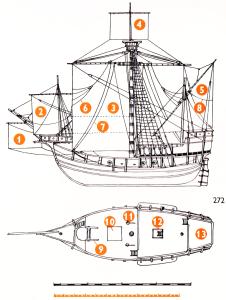 Columbus’ flagship, Santa Maria, ran aground and sank on Christmas Day 1492 off Haiti, on Columbus’ first voyage to the New World. Now after more than a decade’s research, underwater explorer Barry Clifford believes that he has found the wreck of Columbus’ ship. The wreck was originally discovered in 2003, but was not initially ruled out. Clifford told CNN, archaeologists at the time “misdiagnosed” the cannon found on the wreck. Clifford said, “Every single piece fits. Now, of course, we have to go through the whole archeological process, and we plan to do that within the next few months, but I feel very confident that we’ve discovered the site.”
Columbus’ flagship, Santa Maria, ran aground and sank on Christmas Day 1492 off Haiti, on Columbus’ first voyage to the New World. Now after more than a decade’s research, underwater explorer Barry Clifford believes that he has found the wreck of Columbus’ ship. The wreck was originally discovered in 2003, but was not initially ruled out. Clifford told CNN, archaeologists at the time “misdiagnosed” the cannon found on the wreck. Clifford said, “Every single piece fits. Now, of course, we have to go through the whole archeological process, and we plan to do that within the next few months, but I feel very confident that we’ve discovered the site.”
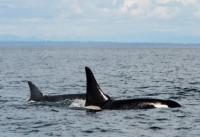
Photo: Capt. Simon Pidcock / Ocean EcoVentures
A belated happy Mother’s day to the matriarch of the J pod, known as J2, but nicknamed “Granny,” by orca researchers who is believed to be 103 years old this year, and still swimming strong. The J pod is a southern resident group of orcas that inhabits the coastal waters from Haida Gwaii in British Columbia to Northern California for about eight months of the year. Remarkably, the centenarian “Granny” and the J Pod just traveled 800 miles in just under 8 days.
In the wild, male orcas live for around 30 years but often live for 50-60 years. Females typically live for around 50 years but as suggested by J2, Granny, can live much longer.
Granny, by the way, poses a problem for Sea World, which claims that orcas live about as long in captivity as in the wild. In the documentary “Blackfish,” one SeaWorld employee states that orcas in captivity live longer. “They tend to live a lot longer in this environment because they have all the veterinary care.” In fact, orcas live far shorter and less healthy lives in captivity. Several scientific studies concluded that captive orcas die at three times the rate of orcas in the wild. Of the 159 captive killer whales that have died, close to 2/3 didn’t make it beyond 10 years in captivity. Only 30 orcas survived more than 20 years in captivity.
This video has been around for some time, but I smile every time I see it. Yes, it is in Dutch, but that hardly matters. Watch until the end. The journalist is interviewing the mayor of the city of Kampen, which is on the the river IJssel. The interview takes place on what appears to be a sailing vessel and the journalist uses what looks to be a brace line for support. One word of advice — don’t lean on the running rigging.
Dutch Journalist falls into water while interviewing the mayor…
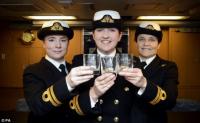
Lieutenants Maxine Stiles, Alexandra Olsson and Penny Thackray (left-right) the first female RN submariners
Like many milestones, once it is past, it doesn’t seem like quite as big a deal. Last week, three women made history by becoming the first female submariners to serve in the Royal Navy.
Female officers have served on US Navy submarines for the past several years. Since the end of the ban on female submariners in 2010, 43 female US Navy officers have served aboard six Ohio-class ballistic-missile (SSBN) and guided-missile submarines (SSGN). Submarines with women currently serving on board include USS Florida, USS Georgia and USS Wyoming, homeported in Kings Bay, Ga., and USS Ohio, USS Louisiana, and USS Maine, homeported in Bangor, Wash.
A rare goblin shark was caught and subsequently released by shrimp fishermen off Key West last week was only the second ever found in the region. The goblin shark is described as ‘a rare, poorly understood species of deep-sea shark. Sometimes called a “living fossil”, it is the only extant representative of the family Mitsukurinidae, a lineage some 125 million years old.‘
Thanks to Phil Leon and Irwin Bryan for contributing to this post.
Kitsap Maritime Heritage Foundation has announced that Seattle attorney Mike Withey is donating the 65′ schooner, Fiddler’s Dream, to the foundation. KMHF was founded in March of 2012 with the stated purpose of being the premiere venue in the Puget Sound region for seekers of an historic seafaring experience; to bring a “tall ship,” or masted sailing vessel, to Kitsap County. The organization’s main emphasis involves exposing elementary-age school children to the ship and knowledgeable volunteers—to be a resource for history and social studies programs throughout the county who want to expose their students to first-hand knowledge of STEM (science, technology, engineering and math).
If you are in the area on Friday, May 9th, at 8PM, be sure to stop by the Noble Maritime Collection at the Snug Harbor Cultural Center at 1000 Richmond Terrace in Staten Island where the legendary British folk singer Hughie Jones will be performing live. There will also be the dedication of a plaque to William Main Doerflinger, the sea shanty archivist who collected songs and stories of the sea at Snug Harbor. Tickets are $15.
See our previous post from May 2011 – The William Main Doerflinger Memorial Sea Shanty Sessions at the Noble Maritime Collection at Snug Harbor & The William Main Doerflinger Memorial Sea Shanty Session – September 18th, 2011
 I was saddened to hear of Farley Mowat’s death, at the age of 92. Many will remember him as an environmentalist and a champion of the rights of native Canadians, as indeed he was. I will remember him for his books about sailing and the sea. He wrote 45 books, most of which were not about the sea. He may be best known for Never Cry Wolf, which was also made into a movie.
I was saddened to hear of Farley Mowat’s death, at the age of 92. Many will remember him as an environmentalist and a champion of the rights of native Canadians, as indeed he was. I will remember him for his books about sailing and the sea. He wrote 45 books, most of which were not about the sea. He may be best known for Never Cry Wolf, which was also made into a movie.
Nevertheless, his books Grey Seas Under and The Serpent’s Coil are classic accounts of the little understood business of deep-sea salvage. Mowat’s very funny book about his misnamed schooner, Happy Adventure, in the The Boat Who Wouldn’t Float should be required reading for any boat owner. Whatever his subject, Mowat was a master storyteller. He will be long remembered.
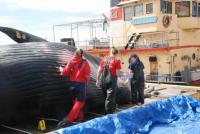 Fin and sei whale are not usually seen in New York’s upper harbor, yet in a period of less than a month, two have made an appearance. Unfortunately, both were dead, pinned to the bows of ships.
Fin and sei whale are not usually seen in New York’s upper harbor, yet in a period of less than a month, two have made an appearance. Unfortunately, both were dead, pinned to the bows of ships.
On the April 12th, a 65′ fin whale was found in Port Elizabeth, carried in on the bow of a container ship. Last Sunday, a 45′ sei whale was carried into the harbor by the cruise ship Norwegian Breakaway. The dead whale may have been related to damage to one of the ship’s pod propulsion units. The damage delayed the ship’s docking by three hours, much to the displeasure of at least some of the 4,500 passengers aboard the ship. Evidence of striking the whale was found on the bow of the cruise ship. A necropsy of the female sei whale was not able to determine whether the whale was alive or not when it was hit by the cruise ship. Fin and sei whales are the second and third largest whales in the ocean, respectively. Both species are endangered.
While the focus in much of the media has been on Japanese “research” whaling, ship strikes pose a far greater risk to endangered whales. Continue reading
Poveglia is a small island located between Venice and Lido in the Venetian Lagoon of northern Italy. Once a quarantine for plague victims, the island contains one or more pits where plague victims were buried en-masse. Some estimates suggest that 100,000 people died on the island over the centuries. It was later the home of a hospital for the mentally ill, which legend has it was run by a cruel doctor who performed unauthorized experiments on its residents. Perhaps not surprisingly, it is said to be the “most haunted” island in the world. It is also available for sale, or more precisely, a 99 year lease from the Italian government.
Not everyone is pleased by the prospective privitization of the island. A group of Venetians has formed the Poveglia Per Tutti (Poveglia For All) association to oppose the sale or lease. The group is seeking help in raising money to buy the island. If you would like to share in the public ownership of an island in Venice with a colorful history, click here: Message-in-a-Bottle.org
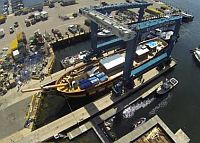 The SSV Oliver Hazard Perry, the largest square-rigged sailing ship built in this country in over 100 years, is nearing completion. The 132′ long three masted steel ship has been hauled at at Newport Shipyard for final exterior work and painting. On the west coast, the Spar Shop at Gray’s Harbor Historical Seaport fabricated the masts, yards and spars on the largest tracer-lathe in North America. The masts, yards and spars have been delivered to the Perry‘s crew of riggers in Portsmouth, R.I. who are finishing the standing rigging. Likewise, Hood Sailmakers is completing the ship’s 14,000 square feet of sails.
The SSV Oliver Hazard Perry, the largest square-rigged sailing ship built in this country in over 100 years, is nearing completion. The 132′ long three masted steel ship has been hauled at at Newport Shipyard for final exterior work and painting. On the west coast, the Spar Shop at Gray’s Harbor Historical Seaport fabricated the masts, yards and spars on the largest tracer-lathe in North America. The masts, yards and spars have been delivered to the Perry‘s crew of riggers in Portsmouth, R.I. who are finishing the standing rigging. Likewise, Hood Sailmakers is completing the ship’s 14,000 square feet of sails.
From the OHP press release:
“The Perry is a modern, steel-hulled ocean-going civilian sail training vessel, with a 13 ½ story rig and 20 sails (made by Hood Sailmakers in Middletown, R.I.) with 14,000 sq. ft. of sail area,” says the ship’s Captain Richard Bailey, a Wellfleet, Mass. native greatly respected for his previous Tall Ship commands and his knowledge of maritime traditions, education and their combined relevance in the modern world. “Her design is based on centuries-old tradition, but her equipment is anything but antiquated.”

